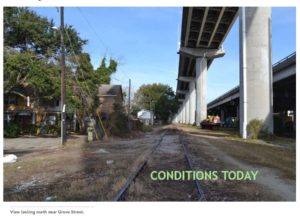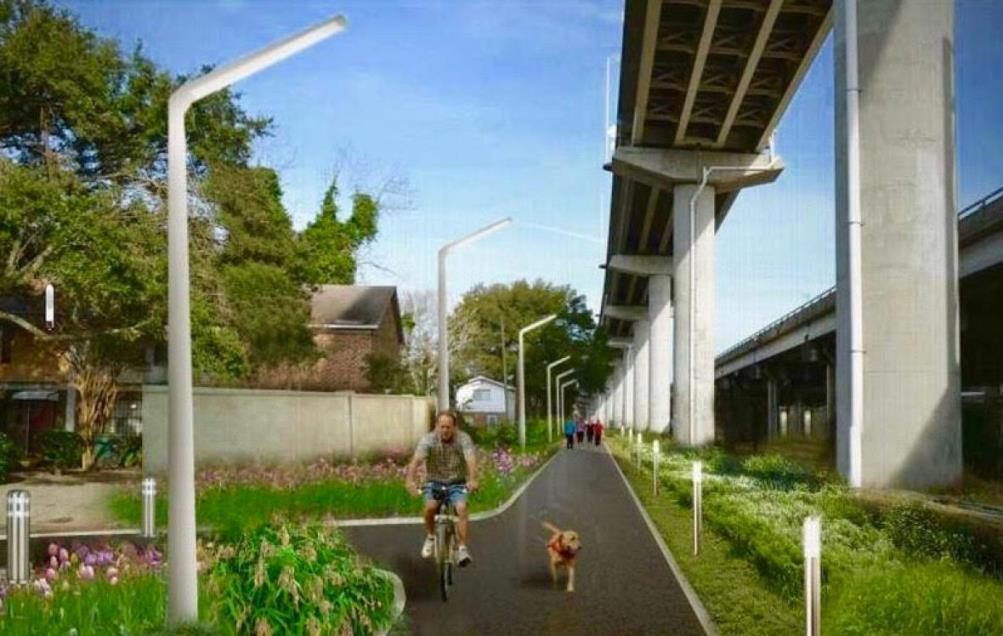Stop me if you’ve heard this one before: A city in the throes of rapid demographic change, where rents are going through the roof, wants to convert an overgrown freight railway into a selfie-ready linear park.
 Here in Charleston, South Carolina, the group behind the “Low Line” (not the first reuse project to use that name) insists that the project won’t do to their town what the High Line has done to a now-astronomically-expensive stretch of Manhattan. The undertaking has the potential to add 9 acres of green space to the city while providing a crucial link for bicyclists and pedestrians, knitting together neighborhoods ravaged by urban-renewal highway projects.
Here in Charleston, South Carolina, the group behind the “Low Line” (not the first reuse project to use that name) insists that the project won’t do to their town what the High Line has done to a now-astronomically-expensive stretch of Manhattan. The undertaking has the potential to add 9 acres of green space to the city while providing a crucial link for bicyclists and pedestrians, knitting together neighborhoods ravaged by urban-renewal highway projects.
It will generate $1.1 billion in economic output including $90 million in tourist spending (if you believe the report prepared by consultant HR&A Advisors) but not displace the low-income, largely black community that flanks its route north of downtown Charleston (if you believe the Low Line’s optimistic proponents).
Does that sound like a pipe dream? The city of Charleston doesn’t think so. It’s currently in talks with the nonprofit Friends of the Lowcountry Lowline and the Norfolk Southern Corporation to spend between $17 and $19 million acquiring the abandoned right-of-way from the freight-rail operator this summer and then selling off two prime parcels for housing to help recoup the acquisition cost.
After that the city will seek another $18 to 25 million converting rail to trail, creating a long path lined with greenery and to-be-determined park features, linking historic downtown Charleston with the residential districts isolated by the construction of the I-26 freeway in 1969. Streets that currently dead-end into no man’s land will instead open onto a verdant public space.
From the Friends of the Lowcountry Lowline Facebook page
Status
Working hand-in-hand with the City of Charleston, the Friends of the LowCountry Lowline (FLLL) has secured a two-year option to purchase approximately 1.6 miles of Norfolk Southern railroad right-of-way stretching from Cortland Street (on the North) to Woolfe Street (at the south). With the purchase option secured, the next challenges are to work with the community to build the vision and secure the funds.
Mission
FLLL seeks to revitalize the historic rail corridor that cuts through the middle of the Charleston peninsula. Working with the community for its input on all aspects, it is our mission to build, program and promote the property as a great public space for all.
What is the vision for the property?
- An open, safe public green corridor in the center of the Charleston peninsula;
- Create pedestrian-friendly linear park in 1.6 miles of abandoned railroad;
- Re-connecting neighborhoods severed by the rail line and I-26;
- Promote neighborhood connections, safety, sustainability and public art.
How will it happen?
- Through public/private partnership among residents, businesses, developers and the City of Charleston;
- Through strong grassroots collaboration between Neighborhood Associations and non-profits with connections to the spaces in and around the property.
Who benefits and how?
- Schools, businesses and residents near the property, as well as regional, national and international visitors and lovers of public green space;
- Communities and adjacent neighbors through innovative strategies to protect and support them;
- We consider the project to be a success only if beneficial to everyone. The more people we reach, the more voices we hear, the more likely we are to create a beautiful and inclusive space for generations to come.
We believe this small but significant tract of land will create a new era of community engagement for the City inspired by the partnerships, voices and actions that make this vision a reality. Note: ”LowLine” is a working title only. As a part of our community dialogue, the permanent name for the property is also on the table.
Rendering of future Low Line by Ginny Deerin.

